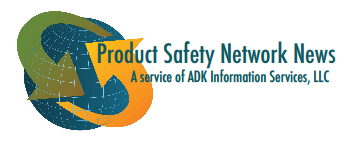3-Year-old dies after tragic window blind cord accident
December 1, 2016, CNN
The daughter of a Brigham Young University coach died after accidentally tangling a window blind cord around her neck. The family shared the news of the tragedy of the 3-year old’s death on social media. CPSC Chairman Elliot Kaye has been addressing the cord safety issues since he was named head of the agency in 2014, referring to it as a “30-year hidden hazard.” The Window Covering Manufacturers Association has previously said it would develop a revised standard for window coverings by the end of the year.
Gree Reannounces Dehumidifier Recall Following 450 Fires and $19 Million in Property Damage; Brand Names Include Frigidaire, Soleus Air, Kenmore and Others
November 29, 2016, cpsc.gov
The CPSC announced that Gree was reannouncing the recall of 2.5 million dehumidifiers that were first recalled in September, 2013, updated in October, 2013, and expanded in January, 2014.
As batteries keep catching fire, U.S. safety agency prepares for change
November 27, 2016, npr.org
. One highly visible “trouble maker” requiring CPSC attention in recent years has been lithium-ion batteries in electronic products, the object of a new initiative by the agency to help it get a broader understanding of the battery industry and how to prevent rather than resolve hazards. With the potential leadership change in leadership following the recent November election, current Chairman Elliot Kaye hopes this work won’t be “scuttled.”
Commissioner Buerkle dissents on “Litigation Guidance” document
November 22, 2016, cpsc.gov
CPSC Commissioner Ann Marie Buerkle explains her reasons for dissenting on a 3-2 Commission vote to approve the “Litigation Guidance and Recommended Best Practices Orders and Settlement Agreements in Private Civil Litigation.” Her concern is about “how the Guidance will be portrayed to courts considering requests for protective orders.”
TSCA UPDATE:
EPA flexes muscle under new TSCA
November 30, 2016, Chemical and Engineering News
In one of its first moves to implement the revised Toxic Substances Control Act (TSCA), the Environmental Protection Agency has announced the first 10 chemicals it will scrutinize for possible risks to human health and the environment. The 10 chemicals were pulled from a list of about 90 substances the EPA previously declared to be a “high priority for safety evaluation because of their potential for high hazard and exposure.”
Asbestos among first ten chemicals to be reviewed under the amended TSCA
November 30, 3016, National Law Review (Schiff Hardin)
Now that the list of 10 chemicals to be reviewed by the EPA has been released, the agency must produce a risk evaluation work plan for the chemicals by June, 2017 and must complete the evaluations within 3 years. If unreasonable risks are found, EPA must take action to mitigate the unreasonable risks.
TSCA and Asbestos – a new approach or one that reveals the same old problem?
December 1, 2016, National Law Review (Schiff Hardin)
Asbestos is different from the other substances on EPA’s list of 10 chemicals it must review for a risk evaluation. In contrast to the other chemicals, “asbestos” is not really manufactured itself even when it’s used in products because in raw form it exists in nature; it has been the focus of massive product liability litigation for a generation; and presents a different set of compliance challenges for industry.
Rubber ducks, teethers, and more: A guide to current and proposed regulations of phthalates in children’s products
November 21, 2016, Lexology (Stinson Leonard Street LLP)
This article traces the evolution of restrictions around the use of phthalates since passage of the Consumer Product Safety Improvement Act of 2008. Currently, the CPSC proposed, and is in the midst of a comment period for, a rule that certain plastics with specified additives would not require third party testing if they do not contain specified phthalates prohibited in children’s toys and child care articles.
EU rules improve bunk and high beds safety
November 23, 2016, Satellite Press Releases
During the past seven years, there have been ten product recalls in Europe for high beds and bunk beds. An amended regulation for these products comes in two parts: EN 747 Part l: requirements related to safety, strength and durability, and EN 747 Part 2: amended test method. Compliance with these standards is mandatory for all bunk beds and high beds being brought onto the European market.
Rep. Kildee pushes lead water rule reforms
November 28, 2016, The Detroit News
A new bill in Congress introduced by Michigan Representative Dan Kildee would require the Environmental Protection Agency to revise federal rules to lower the level of lead contamination considered acceptable in drinking water and revise the permissible techniques for lead testing in water.


